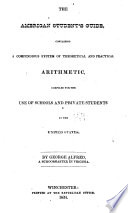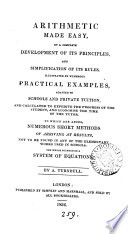 | Frederick Emerson - 1832 - 344 σελίδες
...than the third, make the less of the two remaining terms the second term, and the greater the first. Multiply the second and third terms together, and...product by the first term: the quotient will be the fourth term, or answer. If there are different denominations in the first two terms, they must both... | |
 | George Alfred - 1834 - 336 σελίδες
...require it. 6. When all the terms of the stating are reduced as above directed, (if necessary) — then multiply the second and third terms together, and divide the product by the^rst term — the quotient will be the fourth term or answer to the question, and of Kke name with... | |
 | Stephen Pike - 1835 - 210 σελίδες
...and if the third term consist of several denominations, reduce it to its lowest denomination; then, Multiply the second and third terms together, and...divide the product by the first term: the quotient will je the answer. Note. — The product of the second and third termsis of he same denomination as the... | |
 | Francis Lieber, Edward Wigglesworth - 1835 - 624 σελίδες
...less, place the greater of these two terms on the left, and the less in the middle ; and in both cases, multiply the second and third terms together, and divide the product by the first term for the answer, which will always be of the same denomination as the third term.— Note 1. If the... | |
 | Benjamin Snowden - 1835 - 108 σελίδες
...RULE OF THREE DIRECT. NOTE 1. — Make a stating, and, as in whole numbers, multiply the 2nd and 3rd terms together, and divide the product by the first term, the quotient will be a fraction of the same name as the middle term, and will generally require to be reduced. Examples.... | |
 | Thomas Smith (of Liverpool.) - 1835 - 180 σελίδες
...made it fifteen times too large, divide it by this 15; that is to say, we have the same result if we multiply the second and third terms together, and divide the product by the first. AND THIS is THE RULE ; this, when the terms are properly placed, this MULTIPLYING THE SECOND AND THE... | |
 | Francis Walkingame - 1835 - 270 σελίδες
...proportion, if necessary, to the same name, and the third to the lowest denomination mentioned in it, then multiply the second and third terms together, and divide the product by the first; the quotient will be the answer to the question in the same denomination the third term was reduced... | |
 | A. Turnbull - 1836 - 368 σελίδες
...then reduce the third term to the least denomination contained in it. The three terms thus reduced, we multiply the second and third terms together, and divide the product by the first, and the quotient will be the fourth term in the same denomination, to which the third term has been... | |
 | George Willson - 1836 - 202 σελίδες
...mentioned in it.* * It is often better to reduce the lower denominations to the decimal of the highest. 3. Multiply the second and third terms together, and divide the product by the first, and the quotient will be the answer, in that denomination which the third term was left in. In arranging... | |
 | Nathan Daboll - 1837 - 262 σελίδες
...to the lowest name mentioned in it. 3. Multiplythesecond and third terms together and divide their product by the first term; the quotient will be the answer to the question, in the same denomination you left the second term in, which may be brought into any other denomination required.... | |
| |